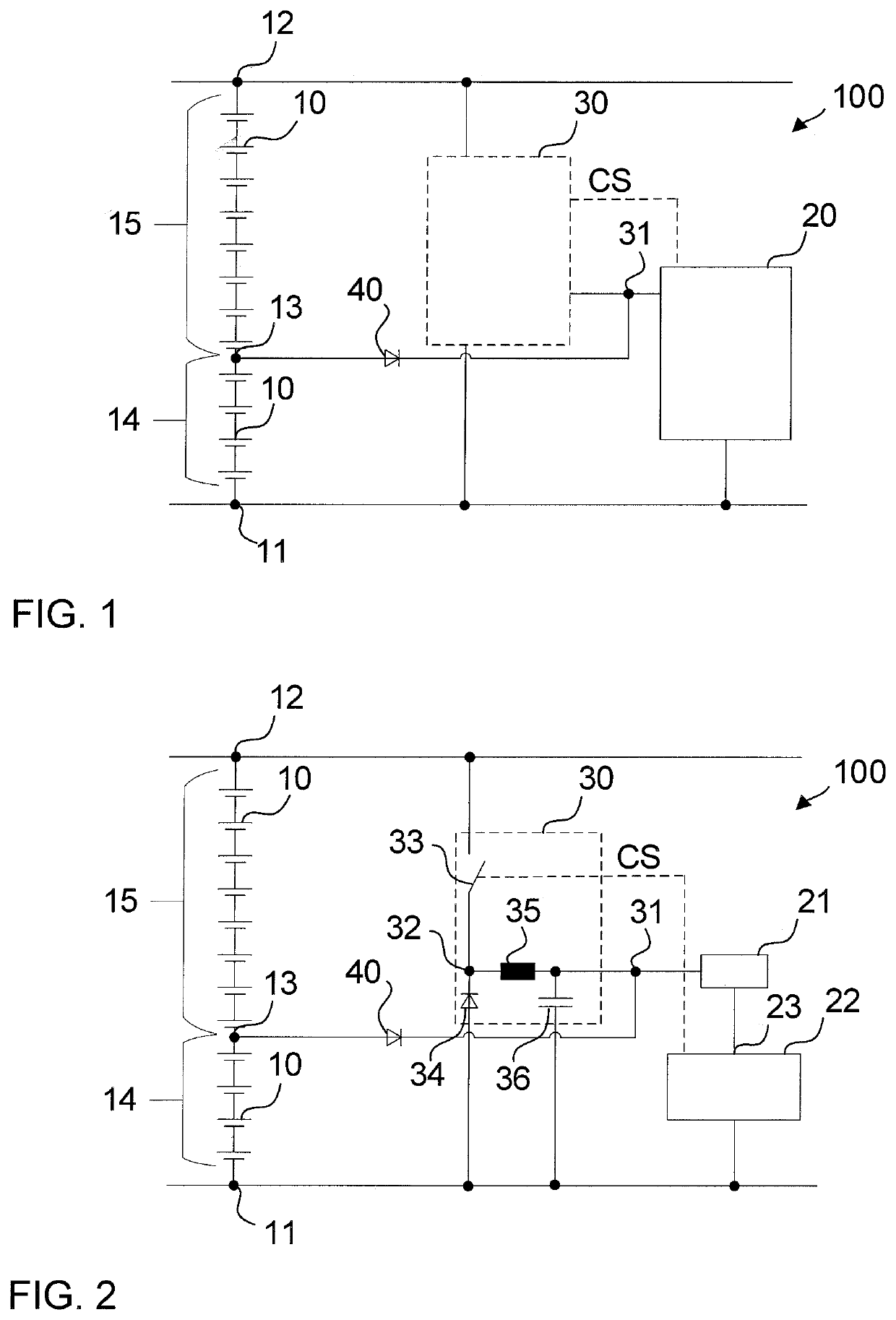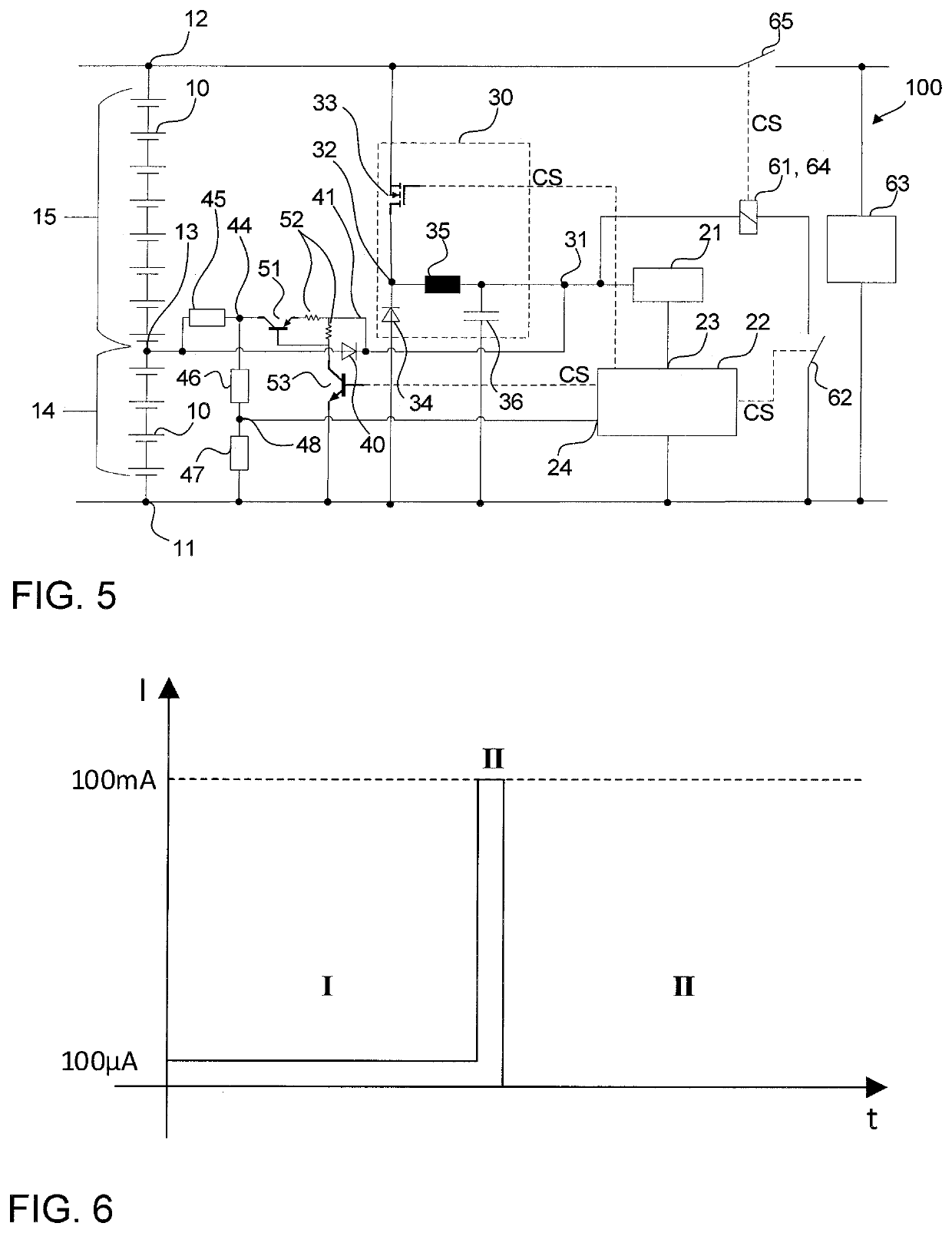Battery system
a battery system and battery technology, applied in the field of battery systems, can solve the problems of insufficient charging, and insufficient static control of battery power output, so as to achieve the effect of effectively avoiding overcharging of the first subset of battery cells
- Summary
- Abstract
- Description
- Claims
- Application Information
AI Technical Summary
Benefits of technology
Problems solved by technology
Method used
Image
Examples
first embodiment
[0044]FIG. 1 schematically illustrates a battery system 100 according to the present invention. The battery system 100 includes a plurality of battery cells (e.g., twelve battery cells) 10 that are connected to each other in series between a first node 11 and a second node 12. Each battery cell 10 provides a voltage of about 4 V so that a voltage of about 48 V is applied between the first node 11 and the second node 12. The stack of battery cells 10 further includes an intermediate node 13 that divides the cell stack into a first subset 14 of battery cells 10 and a second subset 15 of battery cells 10. Therein, four battery cells 10 are disposed between the first node 11 and the intermediate node 13, and eight battery cells 10 are disposed between the intermediate node 13 and the second node 12, but the present invention is not limited thereto. Hence, in the illustrated embodiment, a voltage of about 16 V is applied between the first node 11 and the intermediate node 13, and a volta...
second embodiment
[0047]FIG. 2 schematically illustrates a battery system 100 according to the present invention. In FIG. 2, the same reference signs as those used in FIG. 1 refer to the same or substantially similar components as describe above with respect to FIG. 1 and a repeated description thereof may be omitted.
[0048]In the battery system 100 shown in FIG. 2, the step-down converter 30 is a buck converter 30 that includes a third node 32 and a first switch 33 interconnected between the second node 12 and the third node 32. The buck converter 30 further includes a second diode 34. The anode of the second diode 34 is connected to the first node 11, and the cathode of the second diode 34 is connected to the third node 32. The buck converter 30 further includes an inductor 35 interconnected between the third node 32 and the output node 31 and a capacitor 36 interconnected between the inductor 35 and the first node 11 and in parallel with the second diode 34.
[0049]The control unit shown in FIG. 2 in...
third embodiment
[0051]FIG. 3 schematically illustrates a battery system 100 according to the present invention. In FIG. 3, the same reference signs as those used in FIGS. 1 and 2 refer to the same or substantially similar components, and a repeated description thereof may be omitted.
[0052]The battery system 100 shown in FIG. 3 further includes a charging path 41 connected in parallel with the first diode 40. The charging path 41 includes a constant current source 43 and a second switch 42. The constant current source 43 is connected to the cathode of the first diode 40, and the second switch 42 is connected to the anode of the first diode 40. The BMU 22 shown in FIG. 3 is further configured to control the second switch 42 by outputting another control signal CS to the second switch 42. The charging path 41 allows for the charging of the first subset 14 of battery cells 10 by the output voltage of the buck converter 30 via the output node 31.
[0053]When the first switch 33 is set into the non-conduct...
PUM
| Property | Measurement | Unit |
|---|---|---|
| voltage | aaaaa | aaaaa |
| voltage | aaaaa | aaaaa |
| voltage | aaaaa | aaaaa |
Abstract
Description
Claims
Application Information
 Login to View More
Login to View More - R&D
- Intellectual Property
- Life Sciences
- Materials
- Tech Scout
- Unparalleled Data Quality
- Higher Quality Content
- 60% Fewer Hallucinations
Browse by: Latest US Patents, China's latest patents, Technical Efficacy Thesaurus, Application Domain, Technology Topic, Popular Technical Reports.
© 2025 PatSnap. All rights reserved.Legal|Privacy policy|Modern Slavery Act Transparency Statement|Sitemap|About US| Contact US: help@patsnap.com



